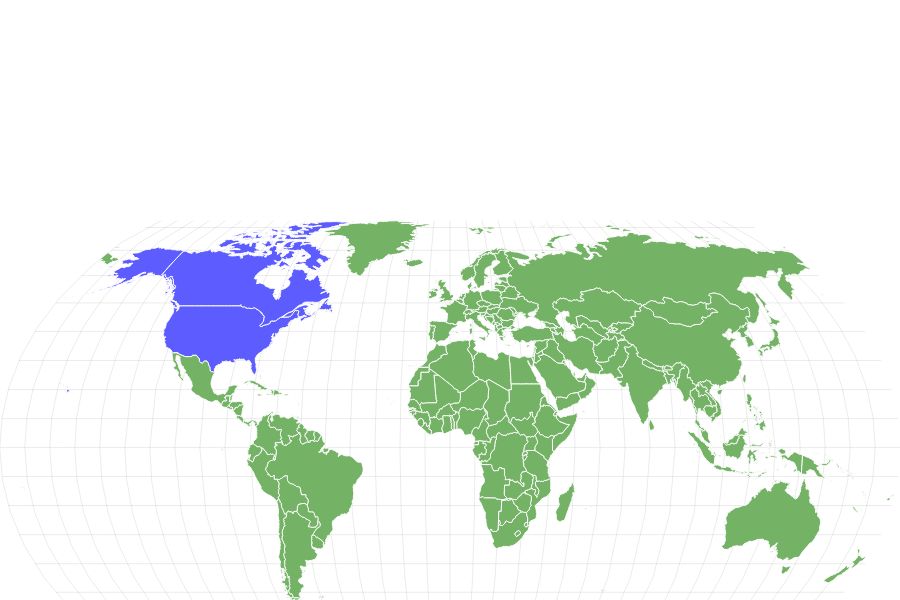Sculpin
Its skull bones can compress so the fish can fit in narrow spaces
Advertisement
Sculpin Scientific Classification
Read our Complete Guide to Classification of Animals.
Sculpin Conservation Status
Sculpin Facts
- Prey
- Fish eggs, insects
- Group Behavior
- Solitary
- Fun Fact
- Its skull bones can compress so the fish can fit in narrow spaces
- Estimated Population Size
- Unknown
- Biggest Threat
- Dam construction
- Most Distinctive Feature
- Spiny fins
- Other Name(s)
- Sea scorpion
- Gestation Period
- 5-7 days
- Habitat
- Lakes, rivers, streams
- Predators
- Humans
- Diet
- Carnivore
- Type
- Cottus
- Number Of Species
- 110
View all of the Sculpin images!
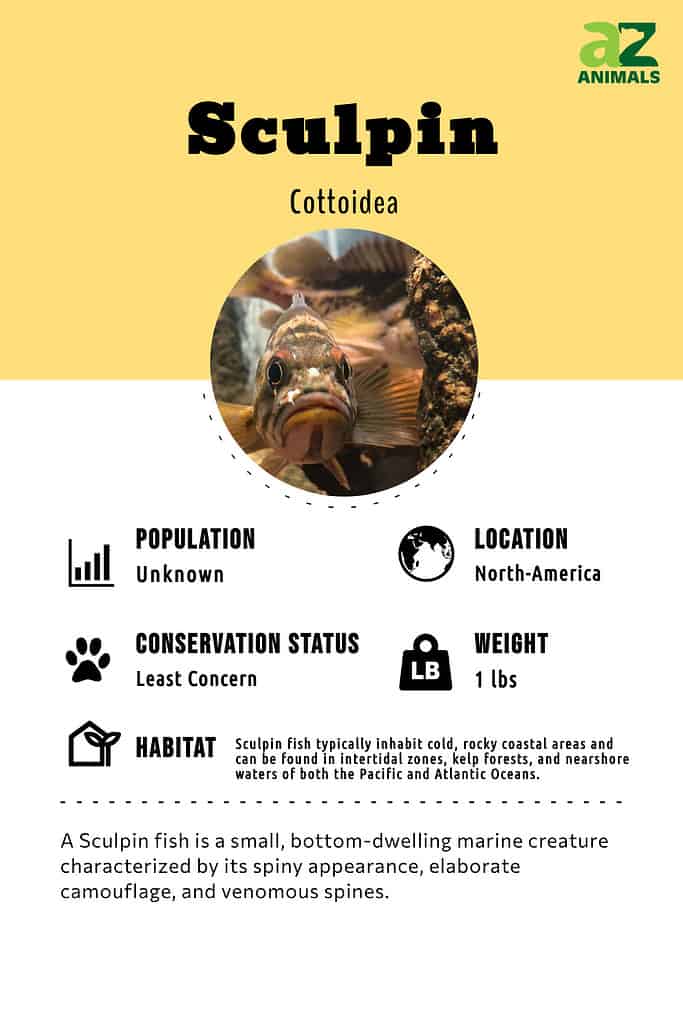
The sculpin fish belongs to the Cottidae family which consists of 110 species.
Some live in freshwater while others live in saltwater. One of the most well-known is the prickly sculpin, also called a sea scorpion. The prickly sculpin lives in rivers and streams in North America running down the western coast from Canada through California.
3 Sculpin Facts
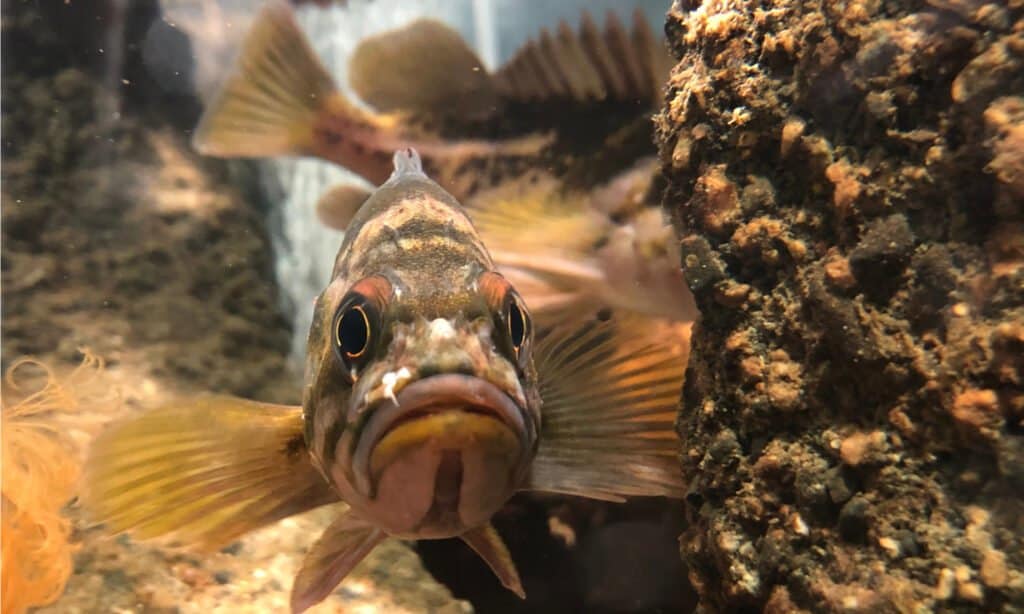
In contrast to other fish species, sculpins lack a swim bladder, which is an organ that adjusts its size to assist in maintaining buoyancy near the water’s surface. Instead, sculpins are specialized for life at the bottom of water bodies, where they dwell.
©Tomy Hovington/Shutterstock.com
- No bladder: Unlike other types of fish the sculpin doesn’t have a swim bladder. A swim bladder changes size to help a fish to float near the surface. Sculpins are bottom-dwellers.
- Breathing through their skin: Sculpins living in low-oxygen habitats are able to breathe through their skin by a method called cutaneous respiration.
- Fanning their young: Male sculpins use their spiny fins to fan their eggs so they receive oxygen.
Classification and Scientific Name
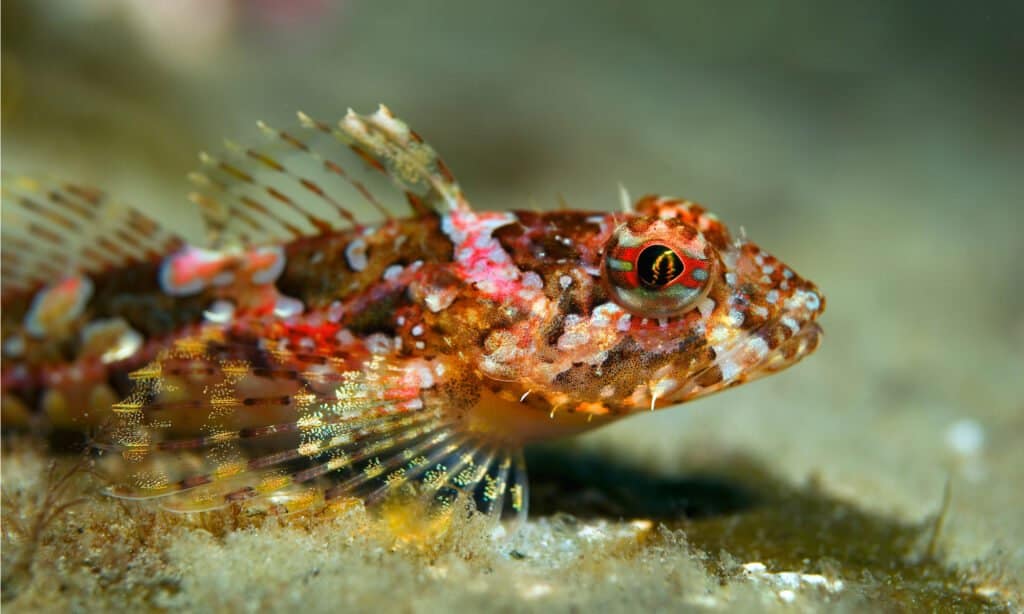
The prickly sculpin fish is scientifically known as
Cottus asper. The species name,
Cottus,
derives from the Latin word for fish, while asper translates to rough, alluding to the presence of prickles on its body.
©Shpatak/Shutterstock.com
Cottus asper is the scientific name of the prickly sculpin fish. The Latin word Cottus means fish and asper translates to the word rough referring to the prickles on its body. Sculpins are also known as sea scorpions and bullheads.
The prickly sculpin is in the Cottidae family and the class Actinopterygii.
Some members include:
- Riffle sculpin
- Black sculpin
- Marbled sculpin
Evolution and Origins
The assemblage, consisting of more than 300 species, holds a prominent position among animal life in the northern Pacific Ocean, where it is thought to have originated.
Sculpins can also be found in the Arctic and North Atlantic oceans, with a few species making their way into the Southwest Pacific, South American, and Southern African waters.
Sculpin, commonly known as bullhead or sea scorpion, refers to a diverse group of fish belonging to the family Cottidae (order Scorpaeniformes). These fish can be found in both saltwater and freshwater habitats, primarily in the northern regions of the world.
Sculpins are characterized by their elongated and tapered bodies, often featuring wide and robust heads.
The Different Species
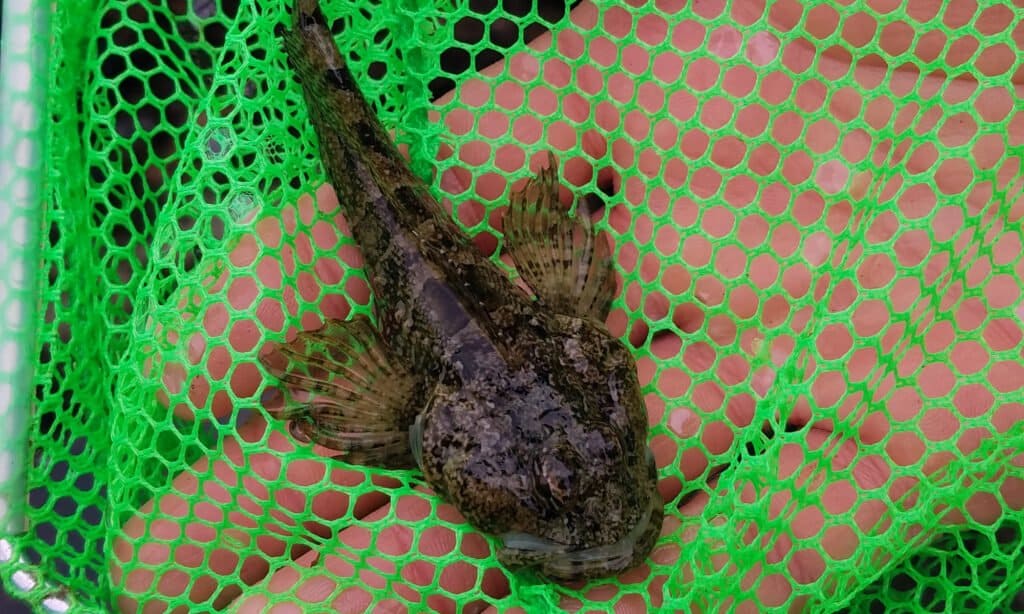
The sculpin species inhabit freshwater rivers spanning from Alaska to California along the western coast. It has the potential to grow up to 11.8 inches in length.
©JortPics/Shutterstock.com
Some types of sculpins live in freshwater while others live in saltwater. Many sculpins live in freshwater streams on the west coast of the United States.
- Prickly sculpin (Cottus asper): This sculpin lives in freshwater rivers from Alaska down the west coast to California. It can reach a length of 11.8 inches.
- Riffle sculpin (Cottus gulosus): Riffle sculpins live in the Columbia River in the state of Washington down the coast to the Morro Bay in California. They’ve mottled skin with brown and red around their fins and reach a length of 4.3 inches.
- Coastrange sculpin (Cottus aleuticus): This freshwater sculpin is two to four inches long when fully grown. They live in streams from Alaska to southern California.
- Reticulate sculpin (Cottus perplexus): These sculpins live in freshwater rivers located in the state of Washington, Oregon, and down into California. They grow to a length of just four inches.
Appearance
The prickly sculpin is olive green or gray with dark brown spots. Its skin is prickly and the spines on its head and fins contain poison. It’s easy for a fisherman to get stuck by this fish’s spines while handling it. The poison causes swelling, and pain, and may lead to infection if not treated.
The prickly sculpin has dorsal, pectoral, and pelvic fins with rays. It also has a head and mouth notably larger in size than the rest of its body.
The dark colors of this fish help it to blend into its sandy, rocky habitat at the bottom of a river.
This fish reaches a length of up to 11.8 inches and weighs around one pound.
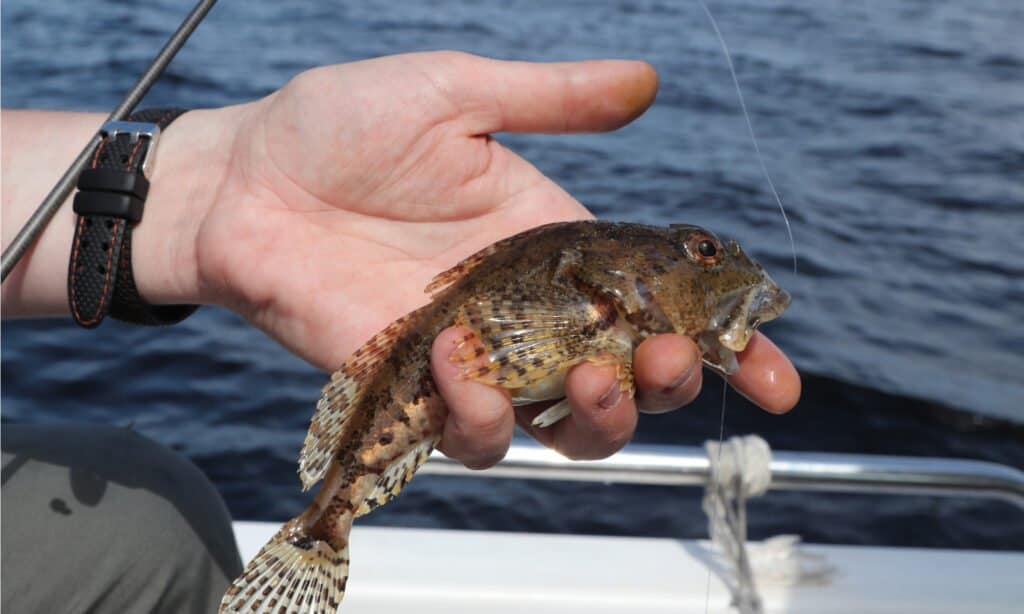
©Nadezhda Malysheva/Shutterstock.com
Distribution, Population, and Habitat
Where to Find: Sculpin and How to Catch Them
Prickly sculpins live on the Pacific Slope on the western coast of North America. Its range extends from Canada down through California. They’re especially plentiful in the Ventura River in California.
One of the most important facts for river fishermen to remember is to look for sunken logs and vegetation where these fish hide. They’re especially active in the springtime.
According to data on the NOAA website, the sculpin stock biomass estimate in 2009 was listed at 33,307 metric tons. Ten years later in 2019, the biomass estimate dropped to 33,010 metric tons.
Predators and Prey
Sculpins are carnivores with a wide variety of creatures in their diet. One of the most interesting facts about this fish is how it can compress its skull bones to fit its head into narrow crevices. This helps it to find more prey to eat.
What eats a sculpin fish?
Trout, smallmouth bass, and walleye consume sculpin fish despite the poison in this fish’s spiny body. These fish also eat sculpin eggs. Humans eat sculpin, as well.
What does a sculpin fish eat?
Sculpins eat insect larvae, fish eggs, and copepods.
The prickly sculpin’s conservation status is Least Concern with a stable population. Mostly, they’re caught recreationally and used as bait or eaten by humans.
Reproduction and Lifespan
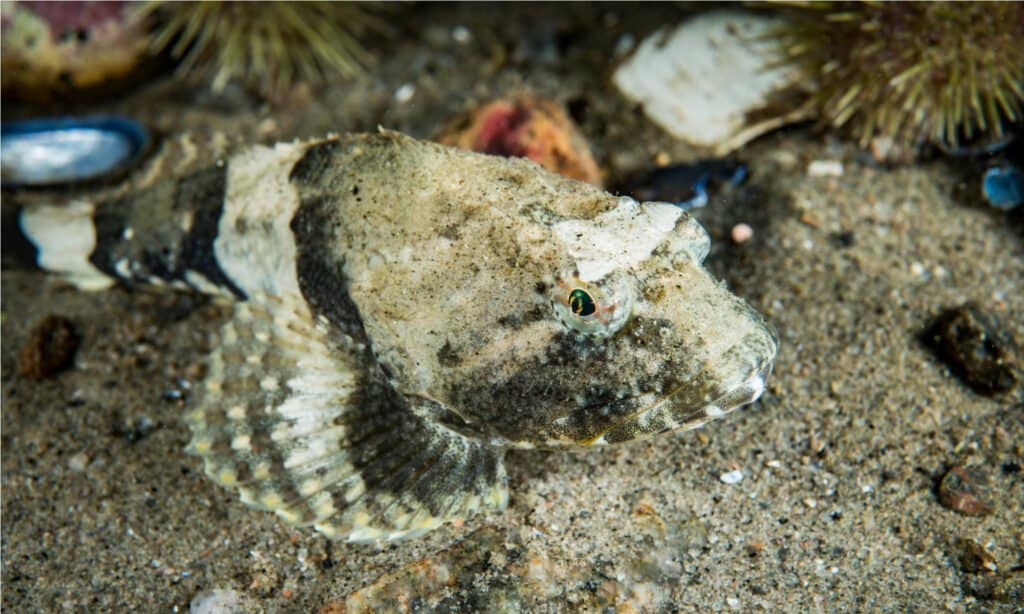
Shorthorn Sculpin underwater in the St. Lawrence River in Canada. Sculpins are bottom-dwellers who do not have a swim bladder.
©RLS Photo/Shutterstock.com
Sculpins spawn in the spring season. The male attracts females by raising his gills and shaking his head as he swims around. In addition, he constructs a cavity or hole beneath a rock or cliff far beneath the water.
After mating, the female turns upside down laying 100 to 600 eggs in the cavity. She leaves the male to guard them. They hatch in five to seven days.
This fish can live up to seven years and is sexually mature at two.
Fishing and Cooking
The poison in the prickly body of this fish makes it challenging to handle and cook. Despite that, some humans do eat them. Recreational fishermen use them as bait for larger fish.
They are most active in the spring when they’re spawning. These fish are caught with lures resembling the copepods and insects in their diet.
Sculpins are consumed by many people in the western part of the United States. Though they’re said to be delicious and high in protein, getting them ready to cook requires some extra work due to the poison in their prickly bodies. A cook preparing a sculpin recipe needs to avoid the spines on this fish’s head!
A sculpin recipe may contain all types of vegetables and fruits such as red onions, cilantro, tomatoes, green onions, and even lime to add spice to the meal.
View all 293 animals that start with SSculpin FAQs (Frequently Asked Questions)
What is a sculpin fish?
Sculpin fish belong to a family of 110 species. They can be olive green, dark brown, or red. They have poison in the sharp spines on their head and grow as long as 11.8 inches.
Where are sculpins found?
Some of these fish live in freshwater while others live in saltwater. They live at the bottom of streams and rivers in North America. Their territory goes from Canada down the west coast through California.
How do you fish for sculpin?
It’s best to fish for a sculpin with a weighted fishing line that can reach the bottom of a river.
Is sculpin good eating?
Yes. A sculpin recipe can be enhanced with spicy sauces containing vegetables, fruit, or both.
Is a sculpin poisonous?
Yes. They have poison in the spines on their head. If a person is poked, this fish’s poison causes pain and swelling.
What kind of fish is a sculpin?
A carnivorous, river bottom dweller.
How big do sculpins get?
Some types can grow as long as 11.8 inches.
Thank you for reading! Have some feedback for us? Contact the AZ Animals editorial team.
Sources
- IUCN Redlist / Accessed April 24, 2022
- Wikipedia / Accessed April 24, 2022
- Washington Department of Fish and Wildlife / Accessed April 24, 2022
- National Park Service / Accessed April 24, 2022
- Biodiversity of the Central Coast / Accessed April 24, 2022
- Pearson Ecological / Accessed April 24, 2022
- Lake Superior Streams / Accessed April 24, 2022

